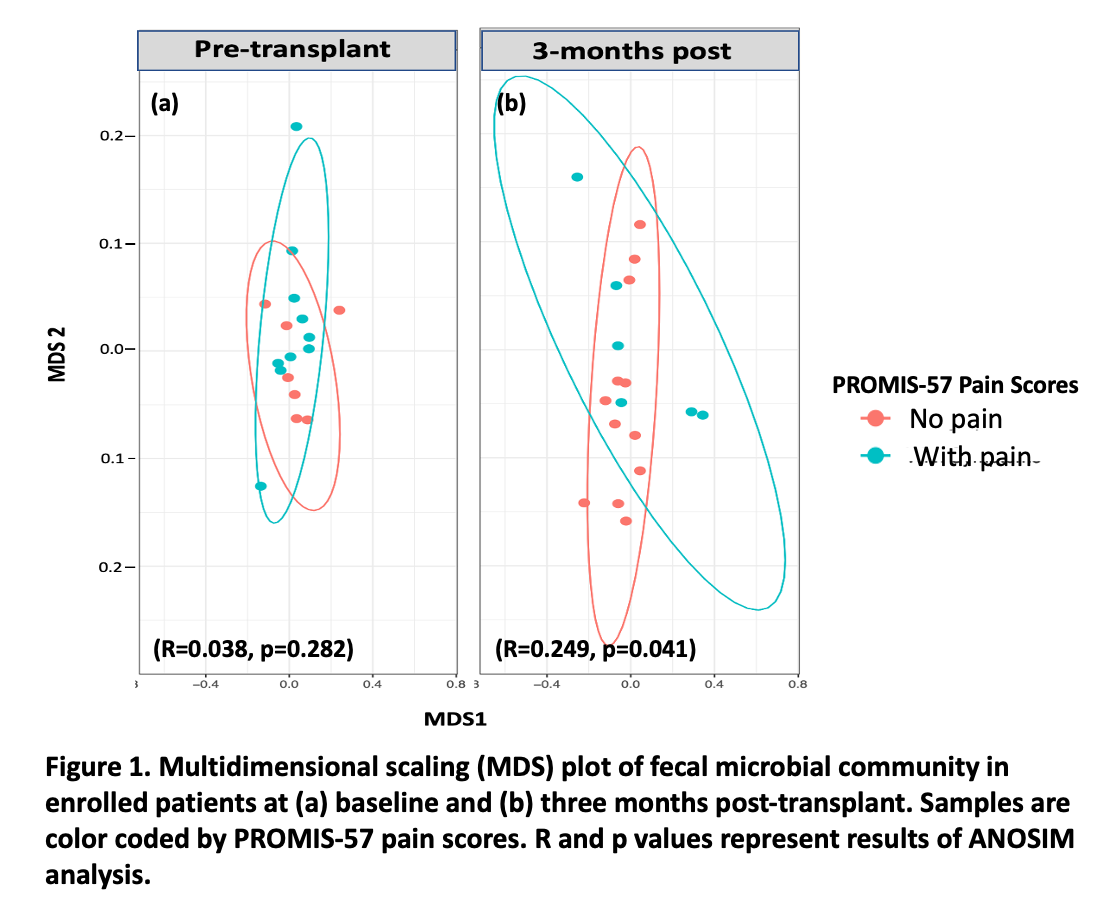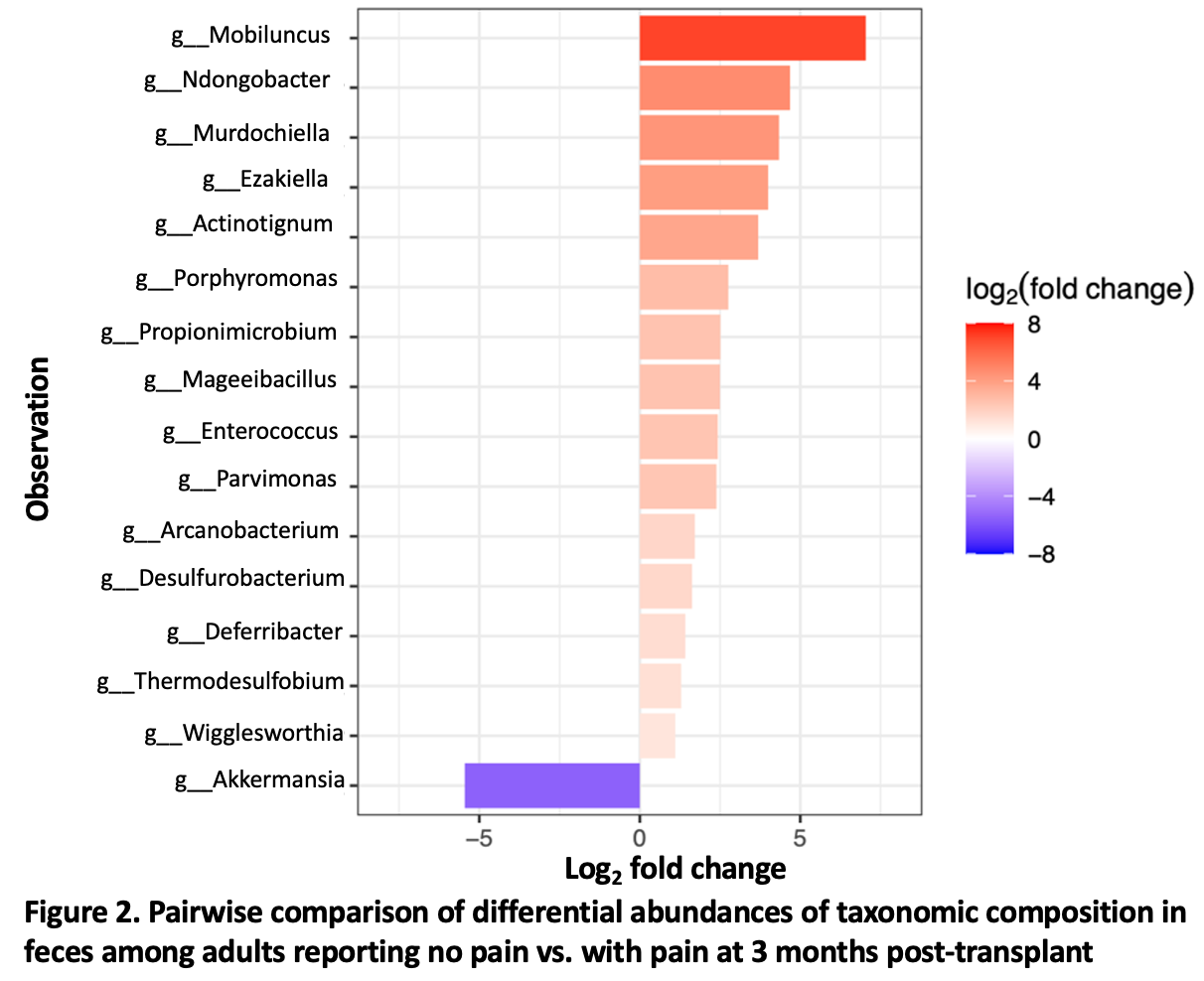The Role of the Gut Microbiota in Pain Interference Before and After Kidney Transplantation: A Pilot Study
1University of Illinois at Chicago, Chicago, IL, 2UCLA, Los Angeles, CA, 3Loyola University Medical Center, Chicago, IL, 4UCSD, San Diego, CA, 5Rush University, Chicago, IL
Meeting: 2022 American Transplant Congress
Abstract number: 1313
Keywords: Genomics, Kidney transplantation, Living donor, Pain
Topic: Basic Science » Basic Science » 16 - Biomarkers: -omics and Systems Biology
Session Information
Session Name: Biomarkers: -omics and Systems Biology
Session Type: Poster Abstract
Date: Monday, June 6, 2022
Session Time: 7:00pm-8:00pm
 Presentation Time: 7:00pm-8:00pm
Presentation Time: 7:00pm-8:00pm
Location: Hynes Halls C & D
*Purpose: To characterize relationships between differential relative abundances of taxonomy (genus level) of the gut microbiome and pain interference before and after living donor kidney transplant(LDKT) in a racially/ethnically heterogeneous sample/population.
*Methods: A longitudinal prospective, repeated measures design of 19 LDKT recipients. Fecal microbiome samples were collected pre-transplant and at 3-months post-transplant. Pain interference scores were derived from the Patient Reported Outcomes Measurement System (PROMIS-57).
*Results: Participants were 37% female, 63% from historically underserved populations with a mean age of 46.5. At baseline, 58% of participants reported pain compared to 37% at 3-months post-transplant. Using ANOSIM, significant differences in beta diversity were found at 3 months post-transplant among those with pain vs. no pain (R=0.249, p=0.041) (Figure 1). Significant differences in gut microbiome beta diversity were also observed among those with pain pre-transplant versus those with no pain 3 months post-transplant (R=0.306, p=0.022), In pairwise models adjusted for false discovery rate (FDR), we noted significant differences in the relative abundance of several taxa between those with pain vs. no pain at 3 months post-transplant (Figure 2). There was a 5-fold log2 reduction of bacteria from the genus Akkermansia among those with pain. A higher abundance of several taxa that have been associated with conditions involving chronic inflammation (e.g. Mobiluncus, Enterococcus, Actinotigum) were found in those reporting pain at 3-months.
*Conclusions: Community structure of gut microbiota differs between those with and without pain at baseline and at 3-months post-kidney transplantation. Several fecal microbiota taxa involved in intestinal barrier integrity and chronic inflammation were associated with pain at 3-months post-transplant. Interrogation of the role of these microbes in pain is warranted in a larger sample.
To cite this abstract in AMA style:
Lockwood MB, DeVon H, Maienschein-Cline M, Chlipala G, Samra M, Lichvar A, Green S. The Role of the Gut Microbiota in Pain Interference Before and After Kidney Transplantation: A Pilot Study [abstract]. Am J Transplant. 2022; 22 (suppl 3). https://atcmeetingabstracts.com/abstract/the-role-of-the-gut-microbiota-in-pain-interference-before-and-after-kidney-transplantation-a-pilot-study/. Accessed December 13, 2025.« Back to 2022 American Transplant Congress


